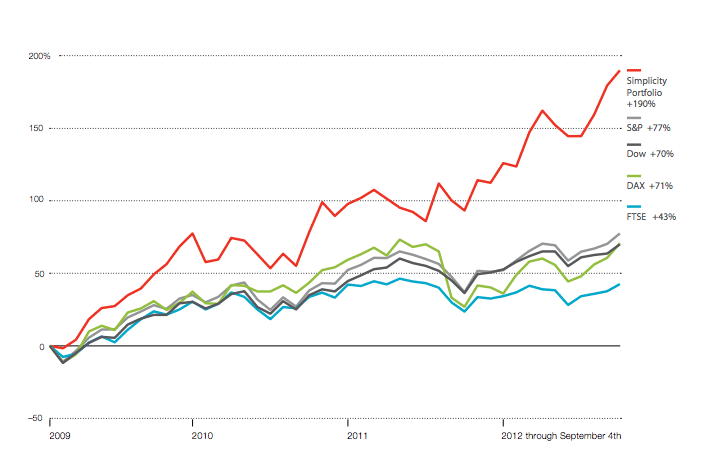Siegel+Gale recently released their research and rankings of the world’s top simplest brands in their 2012 Global Brand Simplicity Index (pdf). Their findings are based on over 6,000 survey respondents across 7 countries. They were asked to evaluate their perception of simplicity or complexity of a brand’s products, services, interactions and communications in relation to industry peers. The data points to a strong correlation between a brand’s simplicity and its financial value. As proof the chart below shows stock performance of the top simplest brands outperforming major indexes.
Paying More for a Simpler Experience
According to Siegel+Gale’s findings, “depending on the industry, up to 60% of people are willing to pay more for simpler experiences and interactions.” Is this surprising? It shouldn’t be if we think about the priority check-in lines offered by some airlines or the assembly and delivery services offered by Ikea. People are willing to pay more if it makes their lives easier. It’s clear from the research that the key to increasing brand value is simplicity.
Simple is as Simple Does
Siegel+Gale boils down what simplicity means for a brand.
Have common sense but no fear. Complexity is, surprisingly, easy to create; it’s the path of least resistance, letting things happen, not making the tough choices. Simplicity takes courage, but the reward far outweighs the risk.
Make it simpler to innovate. Empower employees to share ideas and make innovations happen. Foster creative thinking and use the brand as a filter for refining the right ideas. Coordinate your internal and external resources to speed up execution.
Accept no man-made boundaries. Transform the language in the master contract into plain language. Give the product away for free and then provide services at a premium. Get a premium for your product by going above and beyond on every free service. Don’t just rethink your communications, rethink your business.
Get an outside perspective. Sometimes it’s hard to see the forest for the trees. What you believe to be true internally is not always what the market thinks of you. A second opinion has never hurt anyone.
Know your customer. Understand every detail of the customer experience, because simplicity isn’t as intuitive as you may think: Bigger is not always better, and small is not always beautiful.
Have a big heart. Place empathy for the customer at the heart of product, customer service and experience design.
— Siegel+Gale. “2012 Global Brand Simplicity Index.” www.siegelgale.com. October 2012.
The Courage to Make it Simple
To create a simple experience or product sounds easy enough, but actually requires more thought and courage. It’s easier to give the customer numerous options, but courage is needed to narrow down the choices without fear of losing transactions.
A good example is a restaurant’s menu. Ever been confused by the number of choices on a menu? On the other hand, think about the times when ordering at a restaurant with much fewer options. With less options, we’re able to make a decision more quickly. This in turn gets the order to the kitchen faster. It also makes it simpler for the chefs when they only have to focus on a few dishes, especially during the peak rush period. They know what to expect and are better able to prepare ahead of time. As a result more people get served more quickly for a better customer experience. The outcome is a higher turn around in number of customers.
Simple Always Wins
If the decision-making process is too complex or the customer experience is too confusing, it’ll be easier for the customer to go elsewhere. We know this from personal experience and now have data to back it up. People already have enough on their minds. Anytime we can make it simpler for them, the more they will appreciate it. Mostly, they will remember it as a positive experience and likely return. When given the choice, people always choose simple over complex.
Think about recent experiences you’ve had with brands that were either positive or negative. What part of the experience was it — the process, interaction or communication? How can the brand improve the experience and what can we learn from it?


